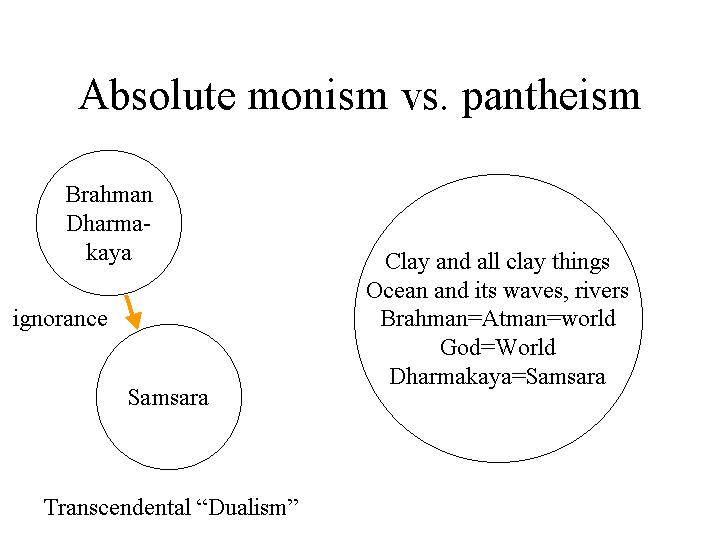
THE LOTUS SUTRA
Sad-|-dharma-|-pundarika
"Fine" Law Lotus Flower
"True" Lotus blossom
"Wonderful" White Lotus
The Lotus Sutra was composed in some local dialect of India or Central Asia (100 BCE-100 CE). It was later put into Sanskrit form, copies of which have now been found.
255 CE: first Chinese translation; 406 CE: Kumarajiva's Chinese translation is considered to be the best translation. 69,384 characters, 8 sections, 24 chapters. Verses (gathas) first; prose parts added.
The Buddha preached it over eight years. To the six realms of existence in early Buddhism, Mahayana adds four higher levels:
1. Hell--Avichi hell the lowest
2. Hungry ghosts
3. Animals
4. Humans
5. Asuras--Titans, demons, anti-gods
6. Gods
7. Shravakas "voice-hearers" saved simply by hearing and following the Buddha
8. Pratyeka-buddhas "self-enlightened ones"
9. Boddhisattvas
10. Buddhas--merged with Dharmakaya?
Main message of Lotus sutra: all beings can aim straight for level ten. Even the most evil person will be saved, including Devadutta, the Buddha's evil cousin. Enlightenment of the naga girl (chapter 12). Even a female animal can be directly saved.
Chapter 25: Bodhisattva Avalokiteshvara (Perceiver of the World's Sounds"; Kuan-yin in Chin; Kannon in Japan) takes on 33 different forms to match any being who is willing to be saved--male, female, animal, etc.
Those assembled include 12,000 monks; 6,000 nuns, including the Buddha's adopted mother Mahaprajapati (Gautami), and his wife Yashodhara. Each had 6,000 and 4,000 accompanying nuns respectively. There were 80,000 Bodhisattvas (8 x 106?); innumerable gods; 8 naga kings; 16 other assorted kings; and the King of Magadha and thousands of his followers.
Equality of women in Mahayana but still sexism, e.g. one woman after gaining great merit (chapter 23) is reborn as a male
The pot vs. prism analogy
Prism analogy explicitly shows plural world to be illusory. Absolute monism
Pots and other clay things are still separate things. Ocean/wave. Pantheism.

•
Prism analogy explicitly shows plural world to be illusory. Absolute monism•Pots and other clay things are still separate things. Ocean/wave. Pantheism.
•
All dharmas are the same Dharmakaya.•
Same in substance only or totally identical?•
“Is” of Identity vs. “Is” of predicationThe "is" of predication
The house is white.
The pot is made of clay.
The ocean, waves, and rivers are water.
Jesus is divine (along with other spiritual beings).
Atman is divine.
The world is divine.
Pantheism uses the "is" of predication.
The "is" of identity
The morning star is the evening star.
Atman is Brahman.
Jesus is God
If Jesus is a Jew, then God is a Jew.
If Jesus is born of Mary, then God is born of Mary. Reductio ad absurdum.
Absolute monism uses the "is" of identity.
KALUPAHANA ON THE LOTUS SUTRA
Main message: One path and goal for all. Simile of the pots, made of the same clay, to hold different things (types of persons). One vehicle (clay) for all. All dharmas (here: beings, entities) are the same ultimately = Dharmakaya. Individual pots have no reality?
Three Stages of Reality/Knowledge
I. Sensual World of Attachment. People are trapped in Samsara
II. The stage of the arhats, shravakas, and pratekeya-buddhas (the last two are on the seventh and eight levels of perfection respectively). A belief in momentary non-substantial dharmas, most closely associated with Abhidharma realism.
III. The stage of the Lotus-sutra. All dharmas are One, which is described as "non-arisen" and "non-ceased" (beginningless and endless), "unbound" (infinite), and "unreleased" (not released), as in "not released" from Samsara. The true Buddha experiences non Nirvana, if it defined as being released from Samsara. All of us are already in Nirvana, the One, the Dharmakaya.
II = Small Vehicle = Hinayana, while III = Great Vehicle = Mayanana
The Small Vehicle is split into two subvehicles: the Shravakas and Pratekeya-Buddhas, making for the three vehicles sometimes mentioned in the Lotus Sutra.
Lotus Sutra
's equivalent of Plato's Parable of the Cave:1. First world people are blind.
2. The scales on their eyes are removed as they are enlightened by the Sun (=Buddha).
3. They all merge with the Sun.
1. If the blind people are substantialists (Hindus?);
2. Then the second people are those who have discovered "dependent arising' (nonsubstantialism);
3. So the third group are those who have transcended (2) to ultimate reality, viz. Dharmakaya.
What is the difference between (1) Atman = Brahman and (3) our Buddha natures = Dharmakaya? At least for Ikeda, the latter is still dynamic and interrelational in its unity of parts.
173: Conceptual transcendentalism only? Kalup suggests?
Level (3) is the Buddha as the embodiment of universal knowledge and compassion, but not a divine substance??
134: Concrete individuals have no place in the Lotus. Analogous to individual pots.
The conceptual pragmatism and virtue ethics of the Buddha becomes in the Lotus a duty ethics of unconditional self-sacrifice.
The Lotus encourages acquiescence to the absolute Buddha, achieved through faith. "Sacrifice of one's own happiness, and even life, becomes an ideal way of life." Seen already in Jataka Tales.
"Unrelinquished, unattained, unannihilated, not permanent, unarisen, uncaused: This is how Nirvana is described" (25.3).Nagarjuna supports Lotus?
Positive Transcendentalism?
We are already and always one with the Dharmakaya.
Nirvana is Samsara; Samsara is Nirvana.
Ethics of the Lotus
The conceptual pragmatism and virtue ethics is now gone.
Lotus: an ethics of duty and total self- sacrifice.
Lotus encourages acquiescence to the absolute Buddha, achieved through faith.
"Sacrifice of one's own happiness, and even life, becomes an ideal way of life."
Already in Jataka Tales.